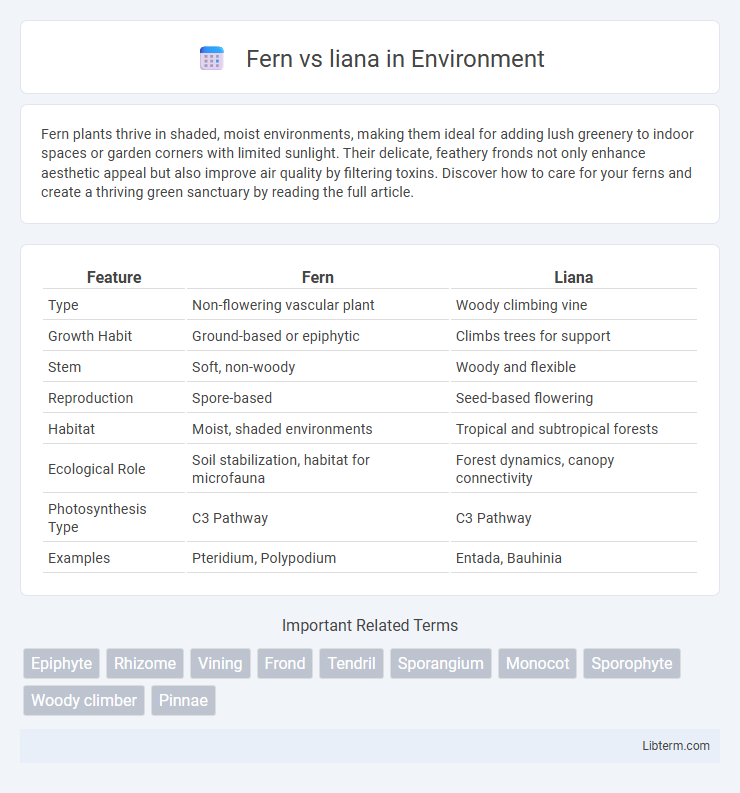Fern plants thrive in shaded, moist environments, making them ideal for adding lush greenery to indoor spaces or garden corners with limited sunlight. Their delicate, feathery fronds not only enhance aesthetic appeal but also improve air quality by filtering toxins. Discover how to care for your ferns and create a thriving green sanctuary by reading the full article.
Table of Comparison
| Feature | Fern | Liana |
|---|---|---|
| Type | Non-flowering vascular plant | Woody climbing vine |
| Growth Habit | Ground-based or epiphytic | Climbs trees for support |
| Stem | Soft, non-woody | Woody and flexible |
| Reproduction | Spore-based | Seed-based flowering |
| Habitat | Moist, shaded environments | Tropical and subtropical forests |
| Ecological Role | Soil stabilization, habitat for microfauna | Forest dynamics, canopy connectivity |
| Photosynthesis Type | C3 Pathway | C3 Pathway |
| Examples | Pteridium, Polypodium | Entada, Bauhinia |
Introduction to Ferns and Lianas
Ferns are non-flowering vascular plants characterized by feathery fronds and reproduce via spores, thriving in moist, shaded environments. Lianas are woody climbing plants rooted in the ground and often found in tropical forests, using trees as structural support to reach sunlight. Both play crucial ecological roles, with ferns contributing to forest undergrowth and lianas influencing forest dynamics and canopy structure.
Botanical Definitions and Origins
Ferns are non-flowering vascular plants classified under the Pteridophyta division, reproducing through spores and characterized by fronds that unroll from fiddleheads; they originated around 360 million years ago during the late Devonian period. Lianas are woody climbing plants predominantly found in tropical rainforests, classified within various angiosperm families, and have evolved structural adaptations to ascend host trees for sunlight access. While ferns represent some of the earliest vascular plants with a distinctive life cycle involving sporophyte and gametophyte generations, lianas are specialized vines arising from flowering plants with complex vascular tissues supporting climbing growth forms.
Morphological Differences
Ferns exhibit fronds, which are large, divided leaves with a distinct central midrib and pinnate leaflets, while lianas typically have simple or compound leaves with varying shapes depending on species. Ferns reproduce via spores located on the underside of their fronds, whereas lianas, being woody vines, produce seeds enclosed in flowers or fruits. Structural differences include ferns' non-woody, herbaceous stems contrasting with the woody, flexible stems of lianas that enable climbing and support in forest canopies.
Growth Habits and Structures
Ferns exhibit growth habits characterized by rhizomatous or erect stems with fronds that uncoil from fiddleheads, thriving in moist, shaded environments. Lianas are woody climbing plants with flexible stems that rely on other structures for support to reach sunlight in tropical forests. The structural adaptation of ferns includes vascularized fronds for photosynthesis, while lianas develop thick, lignified stems enabling extensive vertical growth.
Habitat and Distribution
Ferns primarily inhabit moist, shaded environments such as forest floors, stream banks, and tropical rainforests, thriving in temperate and tropical regions worldwide. Lianas, woody climbing plants, are predominantly found in tropical forests, especially in the Amazon and Southeast Asia, where they use trees for support to reach sunlight in dense canopies. The distribution of ferns extends to a wide range of ecological zones, whereas lianas are mostly concentrated in humid, tropical ecosystems with high biodiversity.
Ecological Roles in Forest Ecosystems
Ferns contribute to forest ecosystems by stabilizing soil with their extensive root systems and providing microhabitats for invertebrates and amphibians, enhancing biodiversity. Lianas play a crucial role by connecting trees and creating canopy pathways that facilitate animal movement and influence forest structure and light dynamics. Both plants contribute to nutrient cycling and ecosystem resilience, but lianas often impact tree growth and survival through their climbing habits.
Reproduction and Life Cycle Comparison
Ferns reproduce via spores released from sporangia typically located on the undersides of their fronds, undergoing an alternation of generations between the multicellular gametophyte and sporophyte stages. In contrast, lianas, which are woody climbing plants mostly comprising angiosperms, reproduce sexually through seed formation after flowering, relying on pollination and seed dispersal mechanisms. The life cycle of ferns is dominated by the sporophyte phase with a free-living gametophyte, whereas lianas follow the standard angiosperm life cycle with dominant sporophyte stages and no independent gametophyte phase.
Adaptations and Survival Strategies
Ferns possess extensive root systems and spore-based reproduction, allowing them to thrive in moist, shaded environments with low nutrient availability. Lianas develop woody, flexible stems that climb and latch onto trees, maximizing access to sunlight in dense tropical forests. Both plants optimize water retention and photosynthesis, but lianas invest energy in vertical growth for canopy access, while ferns focus on ground-level resilience.
Economic and Cultural Importance
Ferns contribute significantly to the horticultural industry and traditional medicine markets, offering ornamental value and bioactive compounds. Lianas play a crucial role in tropical timber and fiber production, supporting local economies with materials for construction and handicrafts. Both plants hold cultural importance in indigenous rituals and folklore, reflecting their integration into the livelihoods and heritage of various communities.
Conservation Status and Future Prospects
Ferns, with over 10,000 species globally, often face habitat loss but many have stable populations due to their adaptability in diverse ecosystems, leading to varied conservation statuses from least concern to endangered. Lianas, crucial for forest structure and biodiversity, are increasingly threatened by deforestation and climate change, prompting conservation efforts to focus on habitat protection and sustainable forestry. Future prospects for both depend on effective habitat conservation, research on species-specific vulnerabilities, and integrating traditional ecological knowledge into preservation strategies.
Fern Infographic

 libterm.com
libterm.com